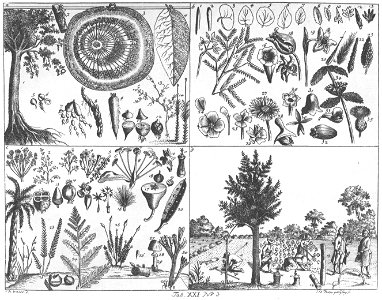Tab. Xxi. No. 3. Of plants. A) a tree 1. Pictured hanging above is a bud 2, the cross-section of a trunk 3, a leaf 4. Above the tree root a germinating seed, as shown by the rootlet 5 shedding its skin 6. A tuberous root 7, scaly 8 and spindle-shaped 9; a dense bulb 10, membranous 11 and scaly 12. A pea tendril 13. Stalks of sugar cane 14. - b) leaves in the shape of an awl 1, a lancet 2, a kidney 3, a heart 4, a circle 5; furthermore another decurved 6, notched 7, serrated 8, toothed 9, arrow-shaped 10, lobed 11, blade-shaped 12 and palmate 13. Three third-partite 14 and bipinnate leaves 15; furthermore flowers, as the funnel-shaped morning glory 16, the rose with its canopy 17, the canopyless tulip 18, the narcissus with the sheath-shaped canopy 19; furthermore a bellow 20, an ear 21, a scaly catkin 22 and a cone 23. A rose-shaped flower 24, carnation-shaped 25, mallow-like 26 and ray-shaped 27; others in the form of a helmet 28, a platter 29, a cross 30, a bell 31, a barrel 32, a butterfly 33, a whorl 34, a button 35. – c) flowers in the form of an umbrella or oarlock 1, a tuft or panicle 2, a bouquet 3 and a bunch 4. A grape 5. A defoliated lily with its six stamens 6 and a stamen 7 in its centre. An orchid flower 10; an onion glass 11. A seed pod with four compartments 12; an acorn 13. A poppy seed pod with holes under the star-shaped lid 14. Two capsules with detachable lids 15. Three kinds of corollas on the seeds 16. A cut pear 17; a nut 18 surrounded by flesh and a berry 19. A pea pod 20. A type of palm 21. Grass 22. Fern 23; a leaf of the same with seeds 24 and two pods filled with them and shown enlarged. Types of moss 25. A sponge or fungus 27. Mold shown enlarged 30. - d) gardening. Cutting the beds. Watering. Weeding, loosening. Laying, sucking, grafting into the bark, into the crack and into the notch. Turning over a tree. (description according to source). Date: 1774.
Loading...
